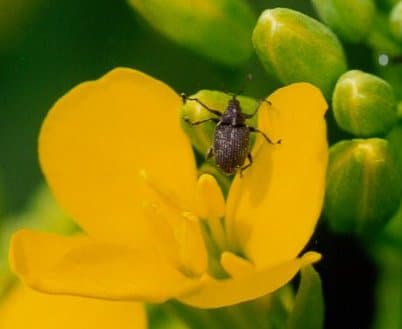
Cabbage seedpod weevil. Source: Dan Johnson
Canola is starting to bolt and flower in southern Alberta, and cabbage seedpod weevils have been observed in the earliest fields. Sweep netting can begin. These guidelines will help with management decisions:
Spraying cabbage seedpod weevil (CSPW) when canola is at the bud stage provides no economic benefit. The goal is to stop adults from laying eggs in newly formed pods. CSPW don’t do their damage until pods are at least 1” long — so aim to spray just prior to that stage, at about 20% bloom. Also, if you spray too early, you may have to go back in with another application (and you can’t spray the same product twice in one season so you may be putting later season insect control in jeopardy). Note: Adults have been around for 2 months and are coming to the end of their lifespan. As they get old, they won’t lay as many eggs. Adult numbers should start to drop off.
Use a sweep net to sample at least 5 spots along the field edge. Click here for tips on how to use a sweep net. If more than 2 per sweep, sample another 5 spots about 150 feet into the field. CSPW will tend to be present in higher numbers in field edges and as they spread out, the number present per sweep will decrease. If you are in a field with variable maturity, sweep randomly and don’t just favor flowering patches. You could easily find elevated numbers in the area that has started to flower, but when the field begins flowering more uniformly, the average number of weevils per sweep will decrease.
The economic threshold is 20 CSPW per 10 sweeps generally across the field. Do not apply insecticide when you have not reached threshold levels. Keep in mind that economic thresholds for CSPW aren’t linear. As the price of canola goes up, you should not decrease the threshold of CSPW per sweep at the same rate. A few insect pests in the field can actually benefit canola because plants stimulated by low levels of damage will overcompensate for that damage. Risk to pollinators is another factor. Insecticides should only be applied to flowering canola if an insect population presents a real economic threat. Otherwise more harm than good can be done if pollination is disrupted and only minor levels of crop pests were present.
When you spray an insecticide, avoid peak sunshine hours of the day when bees and other beneficials will be most active in the field. Note that some of the common CSPW registered products are synthetic pyrethroids that can lose efficacy at higher temps. This is another reason to spray later in the day.
Source: Alberta Canola Producers Commission